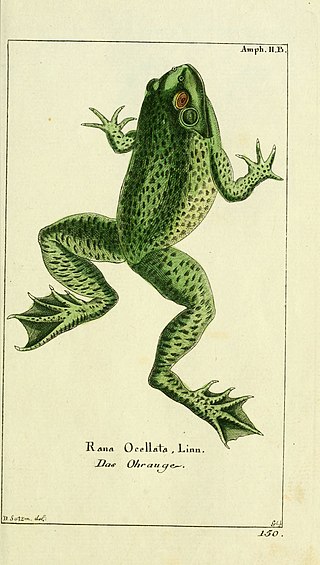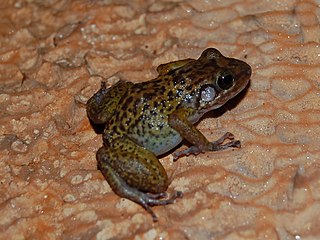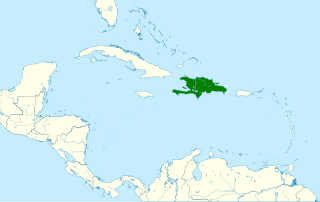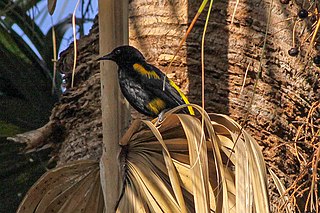
Pico Duarte is the highest peak in the Dominican Republic, on the island of Hispaniola and in all the Caribbean. At 3,101 m (10,174 ft) above sea level, it gives Hispaniola the 16th-highest maximum elevation of any island in the world. Additionally, it is only 85 kilometres northeast of the region's lowest point, Lake Enriquillo, 46 m below sea level. It is part of the Cordillera Central range, which extends from the plains between San Cristóbal and Baní to the northwestern peninsula of Haiti, where it is known as the Massif du Nord. The highest elevations of the Cordillera Central are found in the Pico Duarte and Valle Nuevo massifs.
Peltophryne fluviatica, also known as the Dominican Caribbean toad or Hispaniolan crestless toad, is a species of toad endemic to the Cibao Valley in the northwestern Dominican Republic. It has only been recorded at two localities.

The Hispaniolan hutia is a small, endangered, rat-like mammal endemic to forests on the Caribbean island of Hispaniola. It lives in burrows or trees, and is active at night when it feeds on roots and fruits. A member of the hutia subfamily (Capromyinae), it is endangered from habitat loss and introduced species, such as rats or mongoose.

The Los Bracitos tree frog, or Hispaniolan green treefrog, is a species of frog in the family Hylidae endemic to Hispaniola and found below 1,856 m (6,089 ft) asl. The species was named in honour of professor Angelo Heilprin who funded the expedition that this species was discovered on.

The Jamaican laughing frog is a species of frog in the family Hylidae. It is endemic to Jamaica. Other common names include Savanna-la-Mar treefrog.

The Jamaican snoring frog, or Harlan's Antilles frog, is a species of frog in the family Hylidae endemic to central Jamaica. Its natural habitats are mesic broadleaf woods and forests with large dead trees. It can be found on tree trunks and in bromeliads; males call from hollows in branches and bromeliads. Eggs are laid in bromeliads. It is threatened by habitat loss.
The Hispaniolan yellow tree frog, or common treefrog, is a species of frog in the family Hylidae endemic to Hispaniola, where it is found in both the Dominican Republic and Haiti.
The Hispaniolan giant tree frog, or Hispaniola tree frog, is a species of frog in the family Hylidae endemic to Hispaniola, found in both the Dominican Republic and Haiti.

The Barahona rock frog, or Hispaniola dwarf robber frog, is a species of frogs in the family Eleutherodactylidae that is endemic to southern Hispaniola.
The half-stripe bromeliad frog or Shreve's robber frog is a species of frog in the family Eleutherodactylidae endemic to Hispaniola and found in both the Dominican Republic and Haiti. Its natural habitats are subtropical or tropical moist lowland forest and subtropical or tropical moist montane forest. It is threatened by habitat loss.
Eleutherodactylus inoptatus is a species of frog in the family Eleutherodactylidae endemic to Hispaniola; it is found both in Haiti and the Dominican Republic. With female snout–vent length of about 88 mm (3.5 in), it is the largest eleutherodactylid frog.
The spiny giant frog or Norton's robber frog is a species of frog in the family Eleutherodactylidae. It is named after James W. Norton who accompanied Albert Schwartz in his 1974 expedition to Hispaniola and collected the holotype.
Eleutherodactylus parabates, also known as Independencia robber frog and Neiba whistling frog, is a species of frog in the family Eleutherodactylidae. It is endemic to Hispaniola and found along the crest of the Sierra de Neiba, near the border between the Dominican Republic and Haiti. The specific name parabates is Greek for "transgressor" and refers to this species being the first Hispaniolan member of the "Eleutherodactylus dimidiatus species group" recorded north of the Plain of the Cul-de-Sac–Valle de Neiba.

The Hispaniolan yellow-mottled frog or painted robber frog is a species of frog in the family Eleutherodactylidae endemic to Hispaniola and found in both the Dominican Republic and Haiti. Its natural habitats are dry scrub forest, mesic broadleaf forest, and secondary forest. It is a terrestrial frog that lays its eggs on the ground. It is threatened by habitat loss.

Leptodactylus albilabris is a species of frog in the family Leptodactylidae.

The Hispaniolan spindalis is one of four species of bird in family Spindalidae. It is endemic to the Caribbean island of Hispaniola which is shared by Haiti and the Dominican Republic.

The Hispaniolan oriole is a species of bird in the family Icteridae. It is endemic to the Caribbean island of Hispaniola.

The wildlife of Haiti is important to the country because of its biodiversity. According to the World Conservation Monitoring Centre, Haiti is considered to be "one of the most biologically significant countries of the West Indies". With an estimated 5,600 plant species on the island of Hispaniola, some of which only occur in Haiti, 36% are considered as endemic to the island. A mountainous area country, it is situated in the western three-eighths of Hispaniola and shares a border with the Dominican Republic. There are nine life zones, from low desert to high cloud forests, as well as four mountain ranges, and hundreds of rivers and streams and the coral reefs in the seas that surround the islands. Issues of environmental damage, expanding population, deforesting and erosion are of concern; less than 2% of the original forest remains on account of deforestation. This degradation is traced from the 17th century to 19th century starting with the French colonization of the Haiti and population explosion during the 20th century and for the purpose of forestry and sugar-related industries, degraded the forests. and the environment.
The common tree frog is a species in the shrub frog family, Rhacophoridae.












